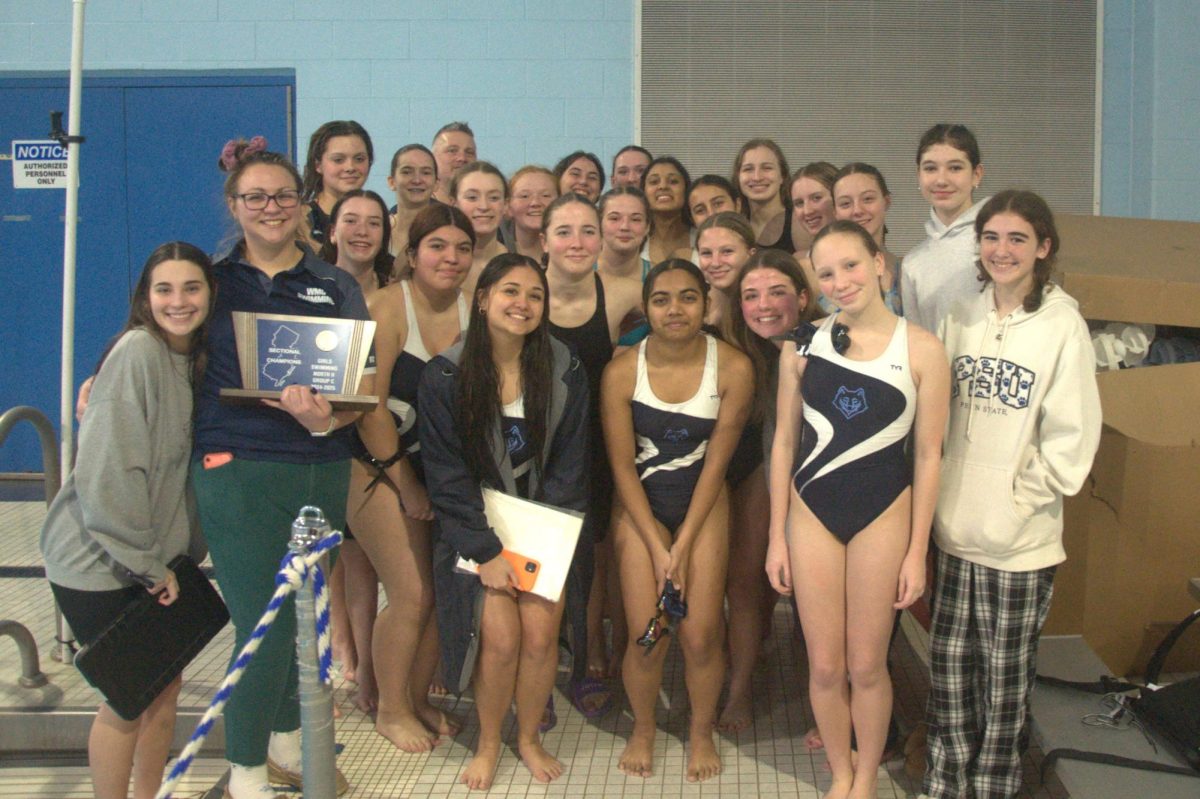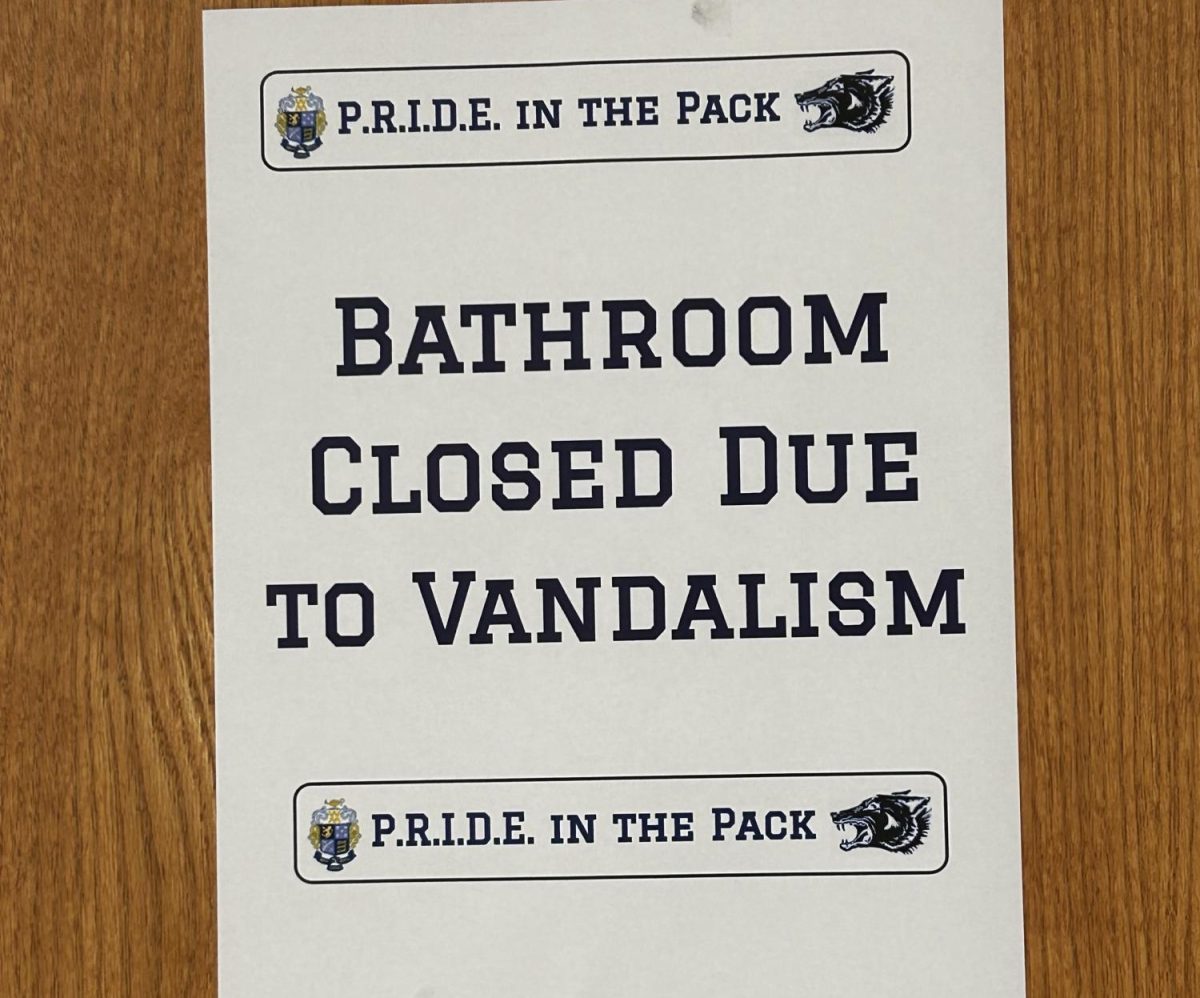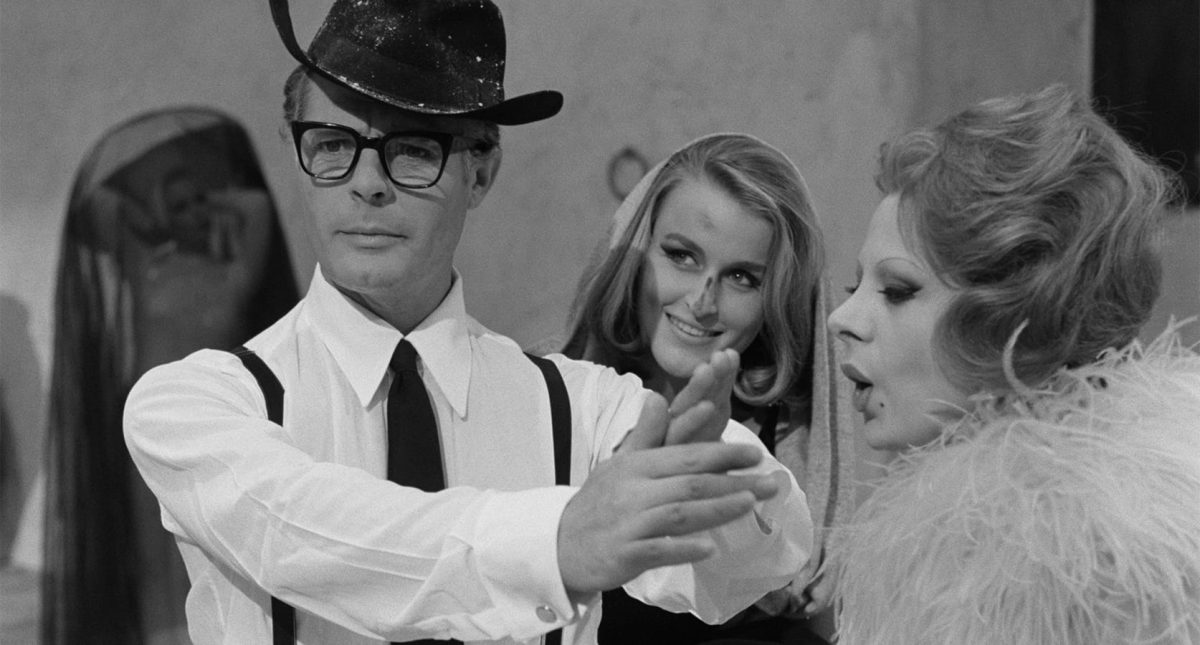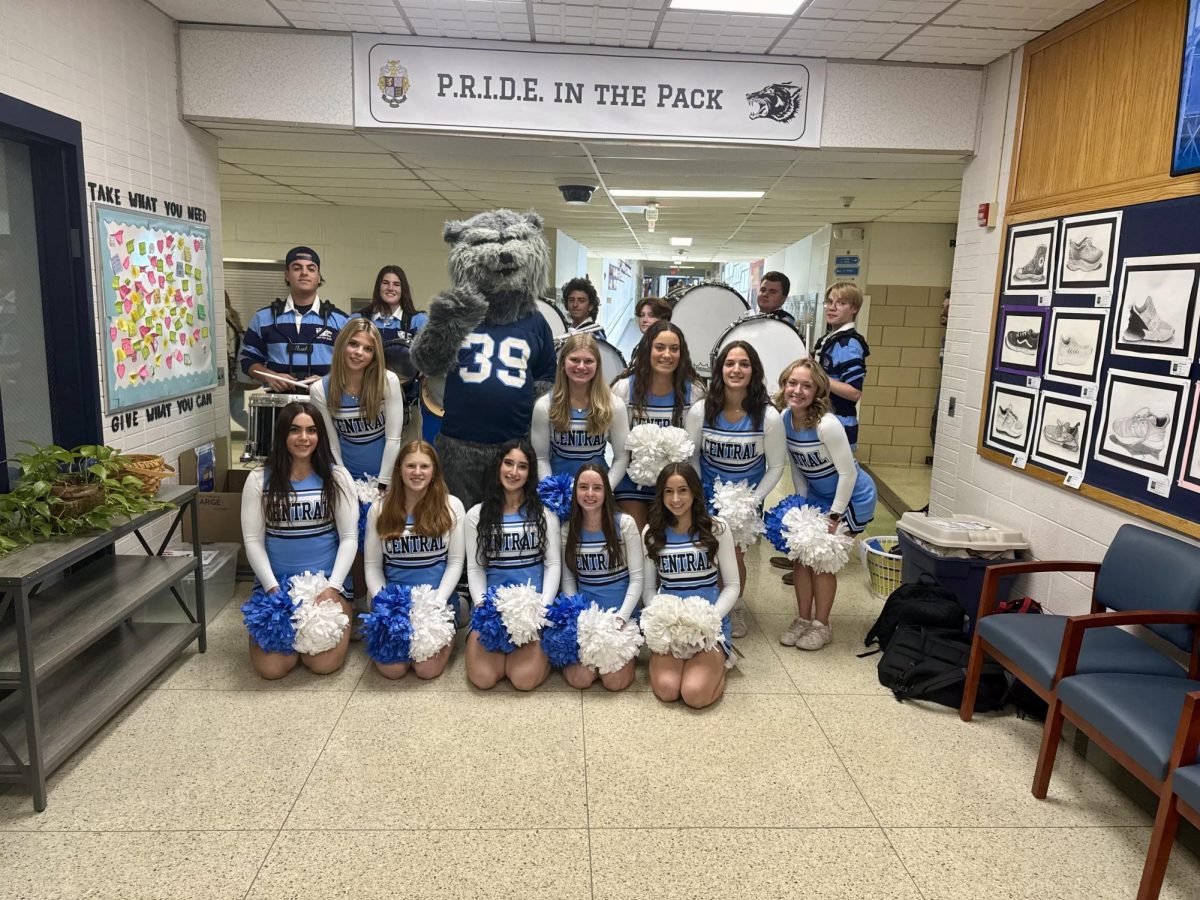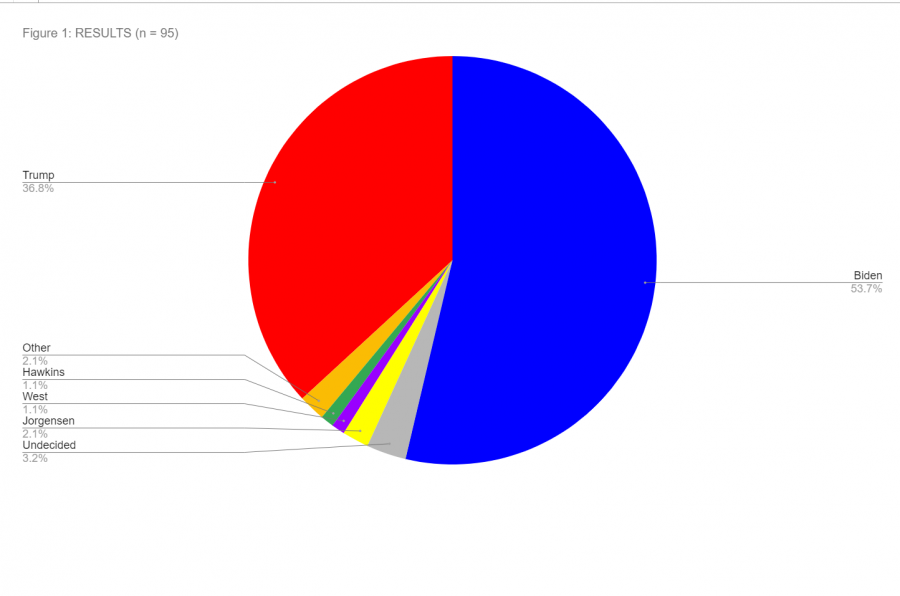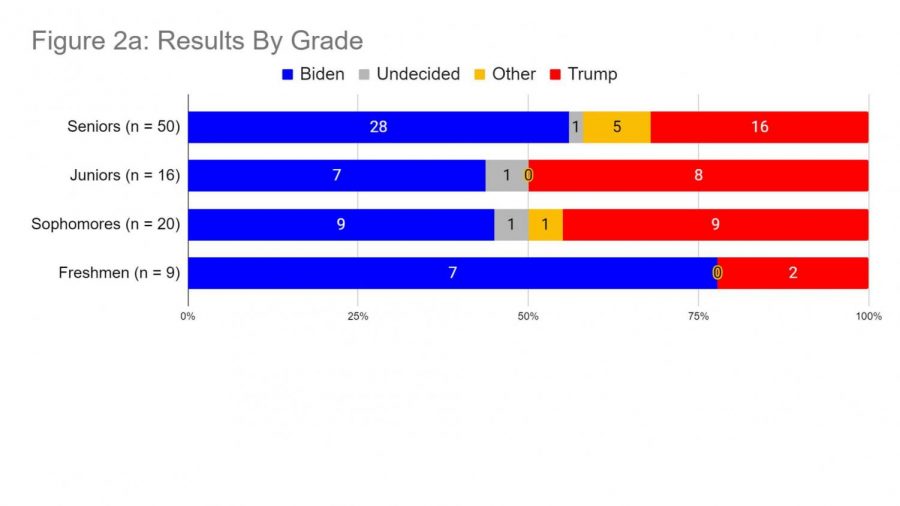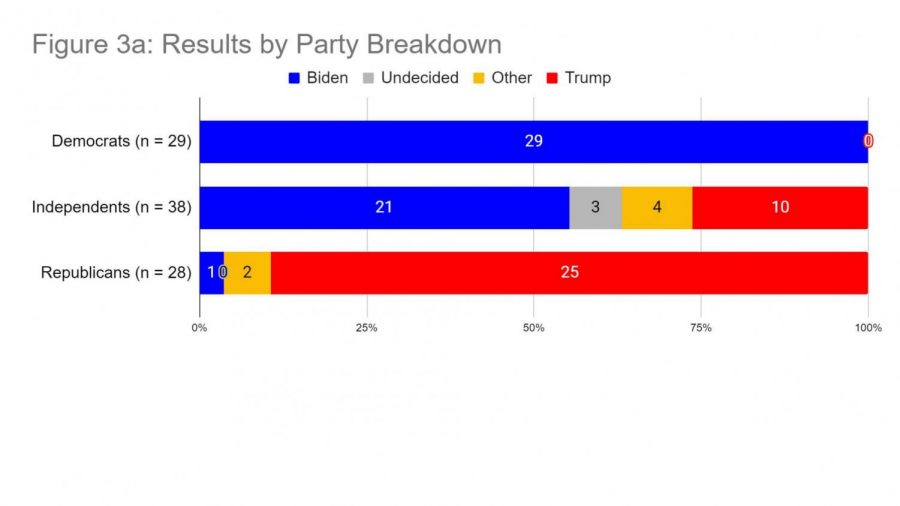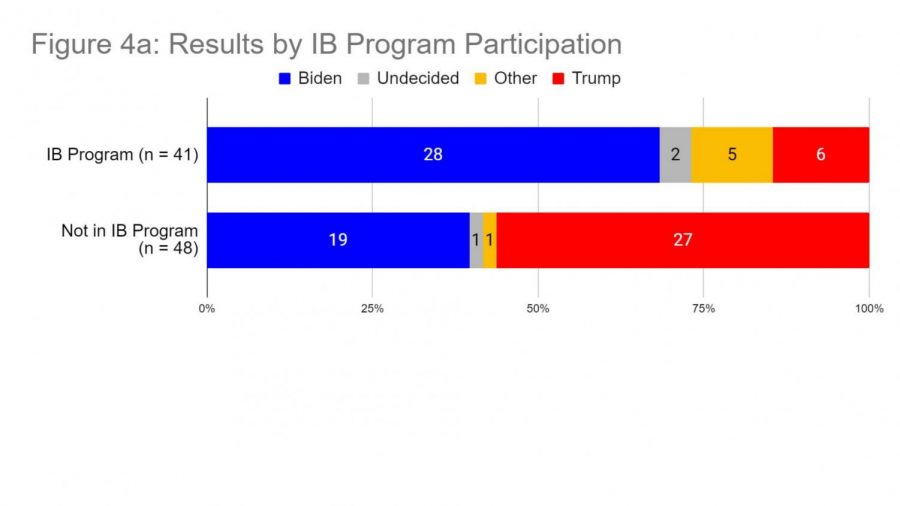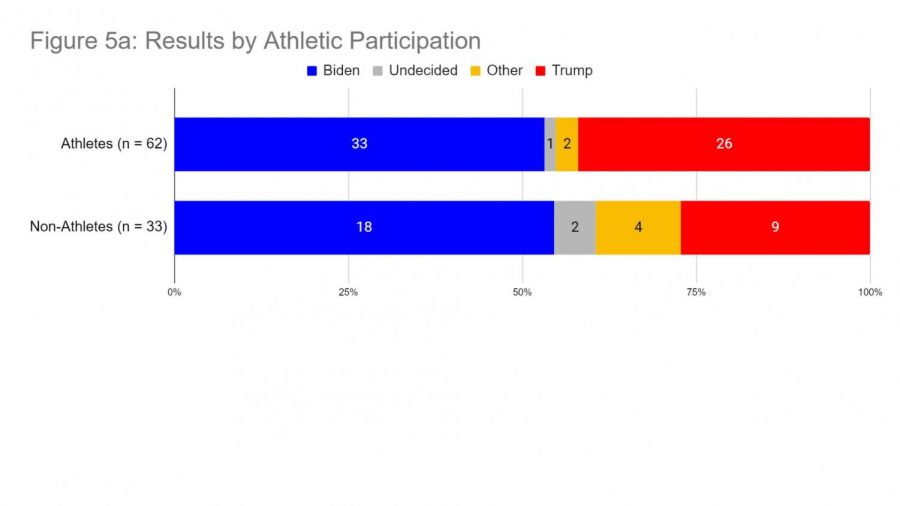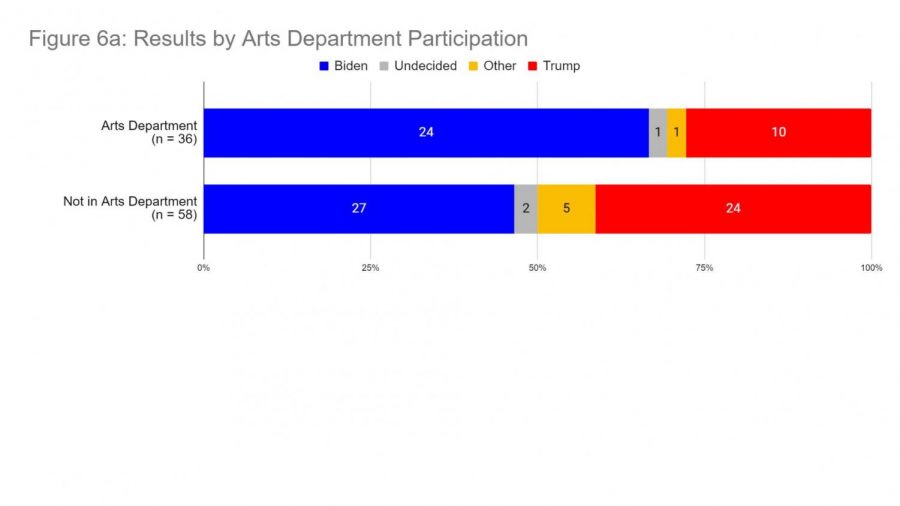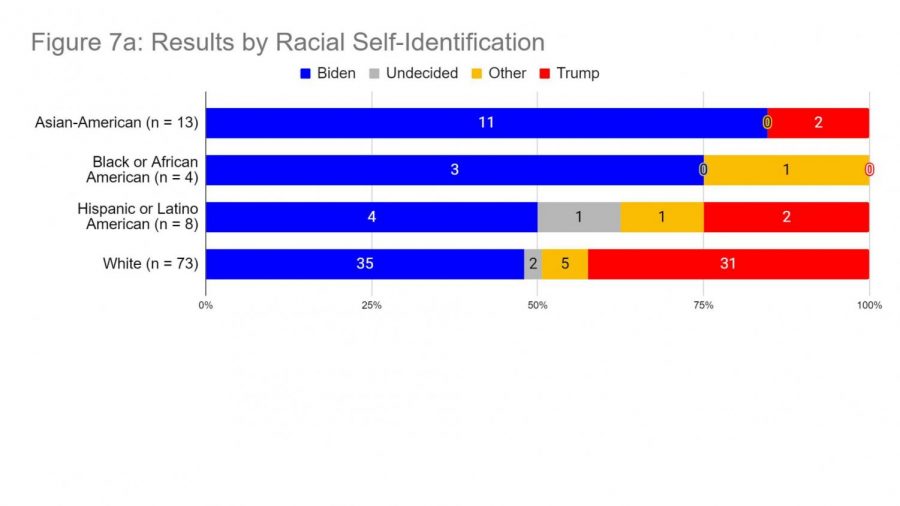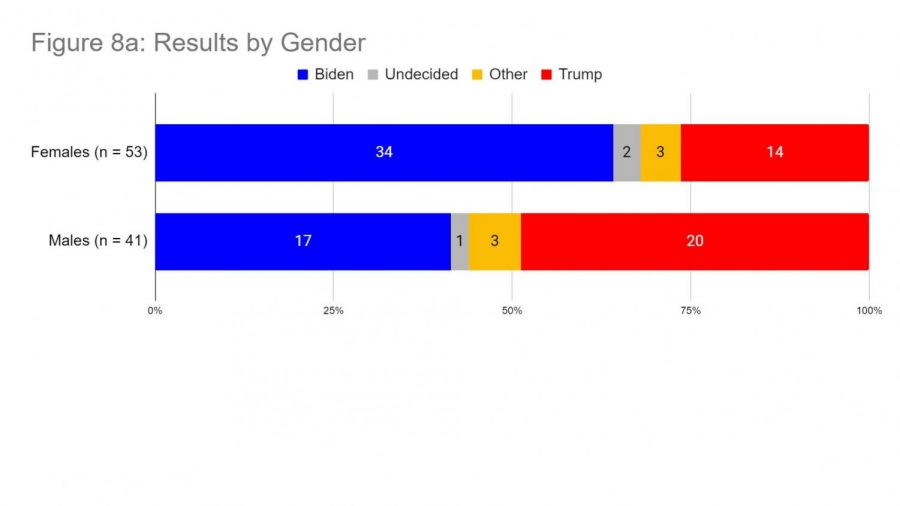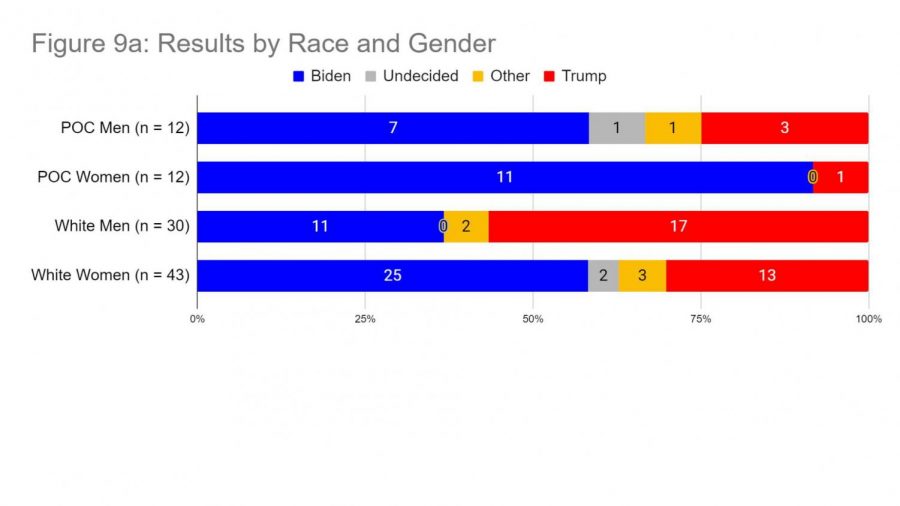WMCHS Paw Print Poll: Biden Leads Trump with Slim Majority
The results of the WMCHS Paw Print Newspaper’s schoolwide poll for the 2020 presidential election are in. Based on 95 responses by randomly selected students, it was determined that Democratic Party candidate Joe Biden holds a statistically significant margin over Republican Party candidate Donald Trump. Biden led Trump by a 17 point margin, 54 percent to 37 percent, well outside the margin of error of ± 9.7 points. In addition, Libertarian Party candidate Jo Jorgenson won 2 percent, while Green Party candidate Howie Hawkins and Independent Kanye West both won 1 percent. A further 2 percent of voters indicated they would vote for some other candidate, and 3 percent were undecided.
These results correlate generally with nationwide polls, which have also shown Biden with a slim but steady lead over Trump. The current RealClearPolitics nationwide average of pollsters has Biden at 51.1 percent to Trump at 43.9 percent, for a margin of 7.2 points. Thus, WMCHS’s 17-point lead for Biden indicates a more Democratic lean compared to the nationwide standard. However, the correlation is closer with statewide polls. The current RCP statewide average for pollsters has Biden at 56.3 percent to Trump at 37.3 percent, for a margin of 19.0 points. Thus, while WMCHS can be said to be more Democratic than the national average, it is more Republican than the statewide average in New Jersey.
Methodology and Grade Breakdown
Participants were randomly selected for the survey based on a random number generator to ensure an accurate representative sample of the student population. They were contacted via text message, social media direct messages, or email. All pollsters were instructed to use a standardized script when contacting students. The only data used in the survey was from students who consented to their participation and the use of their answers to a standardized set of seven questions. Students were also given the option not to participate; all data collected from these students was discarded and not included in the analysis. Further questions about the methodology should be directed to Vincent Jiang at 21_vjiang@s.wmrhsd.org.
During the randomization process, seniors were selected at a higher rate, as they are the only students who potentially can vote in the election. The breakdown by grade suggests that Biden has wider margins of support among seniors (Biden +24) and freshmen (Biden +55), while Trump has wider margins of support among juniors (Trump +6) and sophomores (Even). The apparent high support for Biden among freshmen, with a margin of 55 points, can be attributed to a low rate of response from freshmen, suggesting that the results may be more skewed towards those who are more politically interested. Another interesting result was that the majority of third-party voters came from seniors, which can potentially be attributed to the larger sampling size of seniors.
Results by Party Breakdown
Participants were also surveyed about party self-identification. Students were asked to identify as a member of the Democratic Party, the Republican Party, or an Independent or other party. Approximately equal amounts of self-identified Democrats and Republicans were surveyed, while Independents constituted a plurality. The results showed unanimous support for Biden among self-identified Democrats (Biden +100) while there was more ambiguity among self-identified Republicans (Trump +86), with one self-identified Republican voting for Biden and two self-identified Republicans voting for another candidate. Among independents (Biden +29), Biden won a clear majority with 55 percent of the vote, while Trump trailed with only 26 percent.
This result followed nationwide trends, with both nominees enjoying staunch support from their own parties. Despite the contentious primary for the Democratic nomination, Biden now enjoys high approval ratings from his own party, while Trump has consistently polled very well among Republicans despite some defections. Biden’s strong performance among independents also follows nationwide trends, with such voters backing him consistently in 2020 polls, despite the fact that independents supported Trump against Clinton in the 2016 presidential election.
Results by IB Program, Athletics, and Arts Program
Participants in the poll were also surveyed about their participation in the school community. Students were asked if they were a member or interested in becoming a member of the International Baccalaureate (IB) Program, a school athletic team, or the arts department. The results suggested strong polarization for the IB Program, while the results were closer for athletics or the arts department. Since there is no nationwide equivalent for any of these school community-related questions, no comparisons were drawn between WMCHS results and nationwide or statewide results. Participants who indicated they were unsure about their intentions with any of the extracurricular activities were excluded from this section.
Among the 41 members or prospective members of the IB program surveyed, Biden had a overwhelming majority, with 68 percent supporting him while only 15 percent supported Trump (Biden +53). On the other hand, among the 48 students who indicated they were not members or prospective members of the IB program, 56 percent supported Trump, while only 40 percent supporting Biden (Trump +16). Additionally, IB students were more likely to be undecided or vote third-party than non-IB members. This large degree of political polarization between members of the IB program and students who are not in the program is likely to be of particular interest for readers.
Among the 62 athletes at WMCHS surveyed, Biden had a slim majority, with 53 percent support to 42 percent support for Trump (Biden +11). These results correlate closely to the schoolwide results, with a slightly more Republican tilt. On the other hand, among the 33 students surveyed who indicated they did not participate in an athletic program at WMCHS, Biden had 55 percent support compared to only 27 percent support for Trump (Biden +28). Since the percentage support for Biden was approximately equal between the two subgroups, the drop in support for Trump among non-athletes is largely the result of students who indicated they were undecided or voting third-party.
Among the 36 students who participated in arts department programs (theatre, orchestra, band, or choir) at WMCHS surveyed, Biden had a comfortable lead of 67 percent to 28 percent support for Trump (Biden +37), suggesting that members of the arts department leaned considerably more Democratic than the school. Accordingly, among the 58 students surveyed who did not indicate they were a member or a prospective member of the arts department, Biden’s lead was much narrower, with a plurality of 47 percent compared to Trump’s 41 percent (Biden +6). Similar to the athletic results, members who were not in the arts department were much more likely to be undecided or to vote third party compared to those who did participate in the arts department.
Results by Racial and Gender Demographics
Lastly, participating students were also surveyed about their racial and gender identity. For racial or ethnic identity, students were given the option of selecting from Black or African-American, Asian-American, Native American or American Indian, Hispanic or Latino American, Middle Eastern, Pacific Islander or Native Hawaiian, White, or Other. Students who identified as two or more races are included in the results for both races. For gender identity, students were given the option of selecting from Male, Female, Non-binary, or Other. Additionally, students who were the only member of their self-identified race or gender were excluded for this part of the analysis because of privacy concerns.
Biden led with wide margins among the 13 Asian-Americans polled (Biden +69), the 4 Black or African-Americans polled (Biden +50), with slightly smaller margins among the 8 Hispanic or Latino Americans polled (Biden +25), and a slim margin among the 73 White Americans (Biden +5) included. Asian-Americans and Black or African-Americans both supported Biden overwhelmingly, with 85 percent of Asians and 75 percent of African-Americans intending to vote for Biden. Trump had only 15 percent support among Asian-Americans and 0 percent support among surveyed African-Americans, with the only other self-identified African-American surveyed supporting independent candidate Kanye West.
Among Hispanic or Latino Americans, Biden held a much slimmer majority, with 50 percent support compared to 25 percent support for President Trump. There were much higher rates of undecided and third-party voters among Hispanics and Latinos, with 13 percent of respondents having not made up their minds. Among White Americans, Biden did not have a majority but instead had a plurality at 48 percent of support, while Trump had 43 percent support. There were also a significant number of third party and undecided white voters, comprising a collective 10 percent of voters.
The results by racial self-identification mostly line up with national polls, especially Biden’s overwhelming margins with Asian-Americans and African-Americans. Conversely, commentators have noted Biden’s relative weakness with Latinos, especially in the key swing states of Florida, Texas, and Arizona. Over the last four years, Trump has made considerable inroads with Latinos, improving over his performance in 2016 when he lost Latinos by 36 points to Clinton. Biden’s improved performance among white voters, though, has made up for this deficit, and is a key reason for his stronger performance in the Midwest.
There was also a strong disparity between female and male voters included in the sample. Among the 53 female students surveyed in the poll, 64 percent backed Biden, comprising a clear majority, while only 26 percent backed Trump (Biden + 38). Among the 41 male students surveyed in the poll, however, a plurality of 49 percent backed Trump, while 42 percent supported Biden (Trump +7). Both genders had a roughly equal number of undecided and third-party voters, suggesting that the difference between them is largely attributable to partisanship.
Indeed, the gender divide between the parties has been an increasing trend in recent years. For decades after the ratification of the 19th Amendment, women’s votes were thought to be essentially extensions of the male votes in the family, voting however their husbands or fathers directed to. In recent years, though, as women have gained more political power and autonomy, they have trended towards supporting the Democratic Party at higher rates, while men have generally gravitated towards the Republican Party. The 2020 election, in many ways, has become a culmination of that divide, with Biden enjoying wide margins among women nationwide, while Trump has the backing of men.
Lastly, the results were tabulated by both race and gender; the results for POC men and women were combined together, again for privacy concerns with the small sample sizes. Biden has a commanding lead among women of color, with 92 percent support to just 8 percent support for Trump (Biden +84). His margins among male POC (Biden +33) and white women (Biden +28) were similarly strong, taking 58 percent of both groups to Trump’s 25 percent support among male POC and 30 percent support among white women. While women of color broke decisively along partisan lines, both male POC and white women had considerable numbers of undecided and third party voters, particularly the former.
Among white men, however, Trump dominated, taking 57 percent of the vote compared to just 37 percent for Biden (Trump +20). There were no undecided white male voters sampled in the poll, though there was a sizable 7 percent who opted for third-party candidates. This disparity is again reflected in national polls, with Trump’s bedrock of support coming from white men, while Biden’s inroads with white women have propelled him to the national lead. This demographic chasm in partisan support is again a quirk of recent decades, in particular the gender divide.
Conclusions
While Biden had a slim majority in the WMCHS Paw Print poll for the 2020 presidential election, breaking the results down into components reveals a more volatile race, especially among certain demographics. The most noticeable predictors for political support in WMCHS were undoubtedly partisan identification, IB Program Participation, and gender or racial identification. These are mostly in line with nationwide polling of partisan support and demographic identification. In particular, the surge of political partisanship has made party-crossing and defecting much more unlikely, while the polarization of gender politics has made demographic differences more apparent. On the other hand, the results for athletics and arts department participation revealed a more uniform distribution of political support. Depending on the grade, there was more fluctuation, which can be ascribed to the low sample size of underclassmen in the poll.
In closing, to editorialize slightly, political polling as a science has been a declining art. Ever since the surprising upset of the 2016 election, which defied a whole slew of statewide polls, public opinion towards polls has soured. In particular, the idea of the “shy Trump voter” —a supporter of President Trump who does not feel comfortable telling a pollster his support — has taken root in our common social consciousness. We cannot know for sure whether or not this phenomenon has affected our WMCHS poll, and we make no presumption that it is perfect, or indeed even if it is accurate or not. In the midst of an uncommonly tense election filled with conflict between the two parties past modern precedent, we are oftentimes tempted to look for definitive truth and precise predictions, but polls are an unsuitable substitute for prophecy. The only thing that we can do to contribute something to the truth of tomorrow is to vote.

Vincent Jiang is currently a senior at West Morris Central High School and President of Journalism Club. Passionate about global affairs, he enjoys writing...









